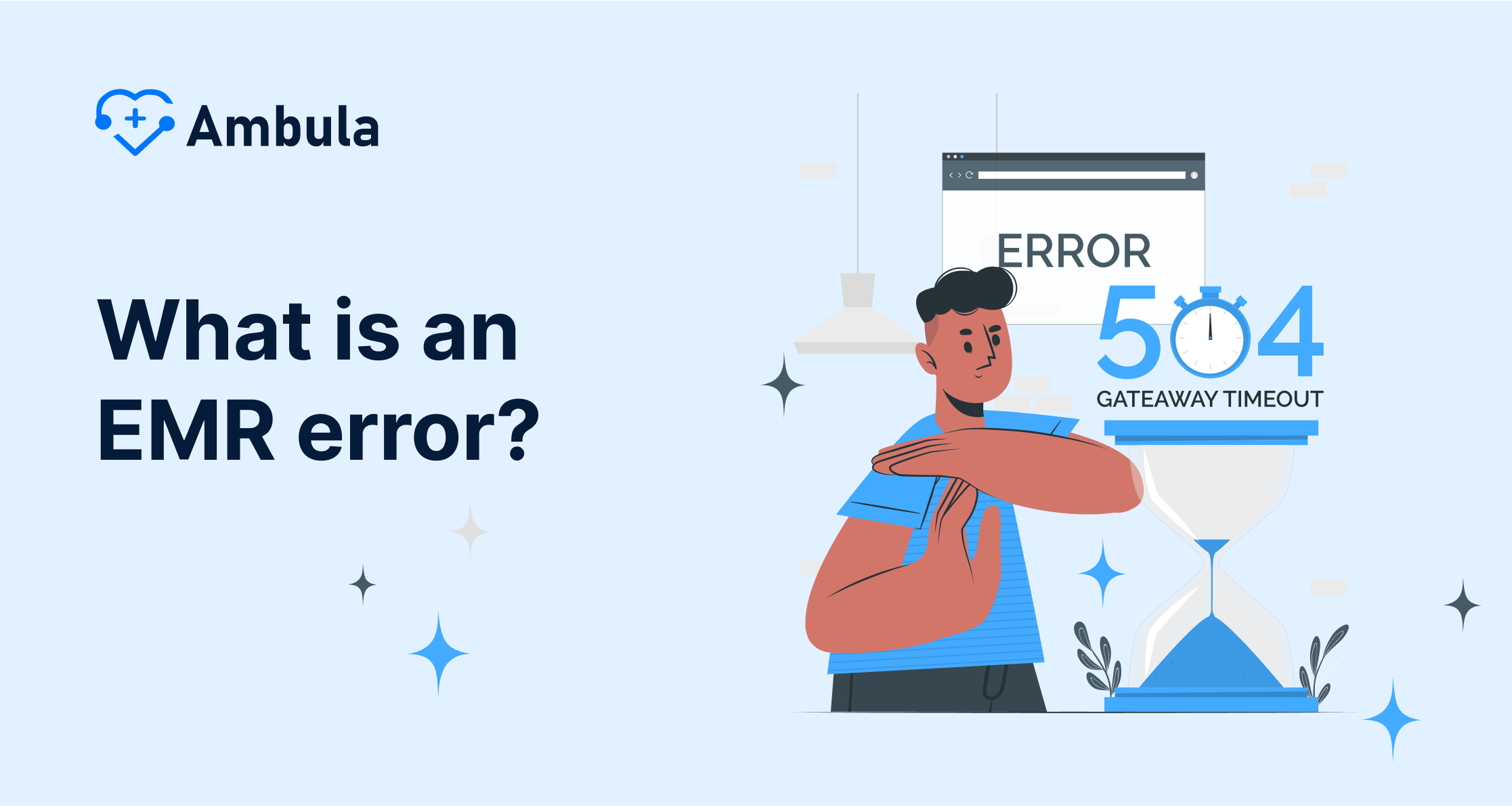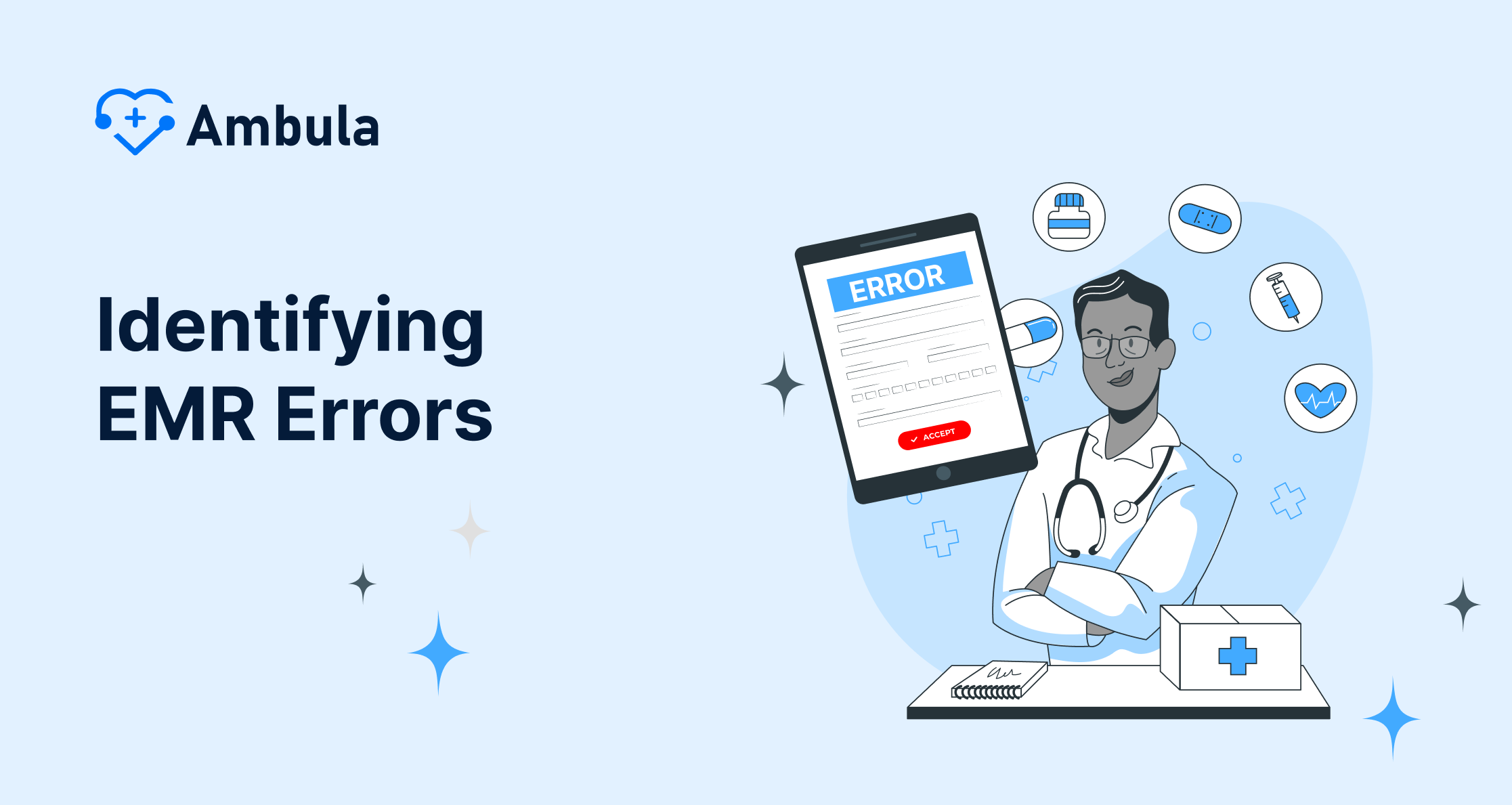How do we correct an EMR error
Topics:
- What is an EMR error?
- Identifying EMR Errors
- What is an EMR experience?
- Correcting EMR Errors
- Managing EMR Error Correction Workflow
- What types of errors occur in EMR?
- The EMR market
- How do you choose the best EMR for your practice?
What is an EMR error?
Errors occur, yet how do we correct an EMR error? If an error happens within your EMR, start by identifying the correct patient with the error in it. Follow it by locating the error within the record.
Electronic medical error refers to mistakes or problems that can occur in electronic health records (EHR) or other forms of health IT. These can include software glitches, data entry errors, interface issues, or missing data that can lead to incorrect patient treatment, misdiagnoses, medication errors, or other harmful health outcomes.
Identifying EMR Errors
Effective error identification is crucial for maintaining the accuracy and integrity of electronic medical records (EMRs). EMRs play a vital role in patient care, and errors in these records can have serious consequences, potentially leading to misdiagnosis, inappropriate treatment, and adverse patient outcomes. Therefore, healthcare organizations must implement robust mechanisms for promptly identifying and correcting EMR errors.
Common Types of EMR Errors
EMR errors can manifest in various forms, including:
-
Data Entry Mistakes: These errors arise from human error during the data entry. Examples include incorrect patient demographics, inaccurate medication dosages, and misspelled diagnoses.
-
Software Glitches: Software glitches can introduce errors into EMRs due to programming or system malfunctions. These glitches can lead to duplicate entries, data loss, or incorrect calculations.
-
Missing Information: Incomplete or missing information in EMRs can hinder accurate patient care. This can occur when relevant clinical data, such as past medical history, laboratory results, or imaging reports, are absent from the record.
Methods for Identifying EMR Errors
Several approaches can be employed to identify EMR errors:
-
Manual Review: Traditional methods involve healthcare providers manually reviewing EMRs for errors. This process can be time-consuming and may not always detect all subtle errors.
-
Automated Tools: Automated error detection tools utilize algorithms and data analysis techniques to scan EMRs for inconsistencies and irregularities. These tools can flag potential errors for further review, increasing efficiency and error detection rates.
-
Patient Feedback: Patients can play a crucial role in identifying EMR errors by reporting discrepancies or inconsistencies they notice in their own records. Patient feedback can be collected through surveys, patient portals, or direct communication with healthcare providers.
What is an EMR experience?
Initially, what is an EMR experience? First, let’s differentiate between Ehr versus Emr, two terms widely used interchangeably. Before we go over How to correct an EMR error. One practice considers EMRs or electronic health records as digitized paper charts containing treatment and medical history. They allow:
- Tracking data in time
- Identifying easily the patients who are due for preventive checkups or screenings
- Improving and monitoring the overall quality of care inside one practice
- Checking how the patients are doing on several parameters
Unlike EHRs, these don’t allow the data to travel outside the practice, limiting the EMR system’s experience.
Check out these articles after you’re done
Correcting EMR Errors
Correcting errors in electronic medical records (EMRs) is a crucial aspect of maintaining patient safety and ensuring the accuracy of medical information. When errors are identified, a prompt and systematic approach to correction is essential to minimize potential harm to patients.
General Principles for Correcting EMR Errors
Several general principles should be followed when correcting EMR errors:
-
Avoid Deleting or Obscuring Original Information: Instead of deleting the original entry, clearly indicate the error and provide the correct information. This maintains a complete record of patient care and allows for future reference.
-
Clearly Indicate the Correction: Clearly mark the corrected entry and distinguish it from the original entry. This ensures that healthcare providers are aware of the correction and can interpret the record accurately.
-
Provide a Reason for the Correction: Briefly explain the reason for the correction. This helps to understand the underlying cause of the error and prevent similar mistakes from occurring in the future.
Preventing EMR Errors
Preventing errors in electronic medical records (EMRs) is of paramount importance for patient safety and the overall quality of healthcare. By implementing proactive measures, healthcare organizations can effectively minimize EMR errors and maintain the integrity of patient information.
Enhancing Data Entry Accuracy and Software Proficiency
Implementing comprehensive training programs can significantly enhance data entry accuracy and software proficiency among healthcare providers, reducing the likelihood of EMR errors. These training programs should encompass:
-
Data Entry Accuracy Training: Healthcare providers should receive thorough training on accurate data entry techniques, including proper formatting, validation checks, and error prevention strategies. This ensures that the information entered into EMRs is accurate and complete.
-
Software Proficiency Training: Training should familiarize healthcare providers with the specific EMR software they use, including its features, navigation, and error-prone areas. This allows providers to effectively utilize the software and minimize the risk of errors arising from unfamiliarity.
-
Error Identification and Reporting Training: Providers should be trained to identify potential errors promptly and report them through established reporting channels. This facilitates timely error detection and correction, preventing errors from going undetected and potentially impacting patient care.
Managing EMR Error Correction Workflow
Efficiently managing the EMR error correction workflow is crucial for ensuring timely, accurate, and consistent error resolution. This involves employing EMR software features, integrating error correction procedures into the overall EMR system workflow, and leveraging technology to streamline the process.
Integrating error correction procedures into the EMR workflow is critical for ensuring efficiency and consistency. This includes establishing clear guidelines and procedures for identifying, reporting, correcting, and verifying errors. Additionally, defining roles and responsibilities for each healthcare team member prevents errors from falling through the cracks. Regular training and education for healthcare providers ensures they are up-to-date on best practices for error management.
Technology plays a significant role in streamlining the EMR error correction process. Automated error detection tools can automatically identify and classify errors, reducing the manual workload and improving efficiency. Centralized error reporting systems collect and track error reports, providing valuable insights for trend analysis and preventive measures. Real-time error alerts notify healthcare providers of critical errors that require immediate attention.
What types of errors occur in EMR?
It is important to learn the types of errors to answer how we correct an EMR error. Two types of errors can occur inside EMR experience healthcare scenarios. Human errors and system errors. You can fix some of these as stated above. Human error types can come from a lack of EMR experience required and might include as examples:
- Using the copy and paste function multiplied as per copying operation repetitiveness
- Errors in entering data while typing from a paper record
- Intentional or. Accidental records deletion
- Data breaches and unauthorized log-ins
How do patients protect themselves from human errors
For the patients to protect themselves from human errors, they should:
- Request a copy of your medical records
- Review their prescriptions
- Look at their lab work
- Keep notes
Normally, EMR software is there to reduce errors. However, some types of errors can happen within the system itself. These types of errors need engineers and your initiative to contact your service provider:
- Increased provider time
- Lack of standards
- Computer downtime
- Threats of confidentiality
Impact of Electronic Medical Errors
- Immediate Impact on Patient Health
The most direct and immediate potential consequence of an electronic medical error is its potential to cause harm to the patient’s health. For example, if a healthcare provider enters incorrect information into a patient’s electronic health record, such as misinformation about allergies or pre-existing conditions, it could lead to incorrect diagnoses or inappropriate treatments. Similarly, if the system fails to highlight a serious drug interaction due to an error, it can lead to dangerous, potentially life-threatening side effects. - Extended and Long-term Impact on the Healthcare System
Beyond the direct harm to the patient, electronic medical errors can have broader, long-term implications for the healthcare system. They can cause delays, as healthcare providers must spend additional time remedying these errors, impacting the efficiency of medical services. This can lead to patients mistrusting electronic systems and preferring manual procedures, hindering technological advancement in the healthcare sector. Furthermore, these errors can lead to increased healthcare costs, as incorrect or inappropriate treatment can prolong a patient’s hospital stay or necessitate additional or more expensive procedures.
The EMR market
Here are some facts to know about the EMR market:
- There are hundreds of companies in the EMR market, which makes it highly competitive and efficient at the same time.
- There are concerns about IT staff because not all medical practices have an IT department to maintain, fix, and implement the software
- The growth of the market has been remarkable, thanks to the incentive
- Security breaches and data storage are top priorities for participants.
How do you choose the best EMR for your practice?
Finally, how do you choose the best EMR for your practice? First, you should know that implementing EMRs takes time and capital. Therefore, you need to choose wisely. Therefore, we present you the steps required:
- Compose a list of your practice’s needs
- Do some budget analysis
- Consider only specialty-specific EMRs
- Take into consideration the systems architecture for your particular practice
- Make sure of the certification of the EMR system
- Take advice from other users
- Decide on the volume of your support
- Get a lawyer to review the agreement of purchase
- Give the right time for installing
Whether the error is human or software-related, the times are advancing towards an error-free environment. Of course, EMR is on the way to accelerating this shift.
For additional information, do not hesitate to contact our Ambula Healthcare team: (818) 308-4108! And now, check out How to operate an EMR system!








